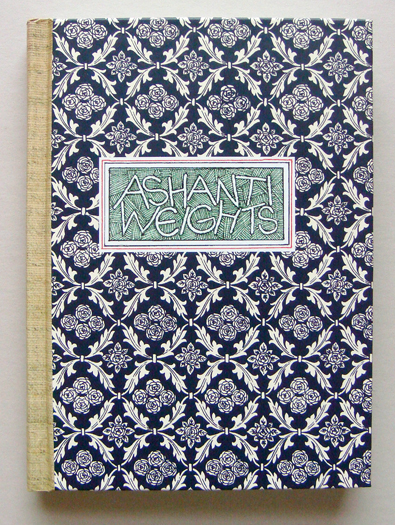Ashanti Weights

Facsimile notebook, edition of 300 signed and numbered copies.
Published by Edition Hansjorg Mayer 2010, hardback 128pp, 171 x 124 x 12mm.
Notes on this work
To coincide with the publication of his African Goldweights Tom Phillips presents a facsimile of an original notebook of his pen and ink drawings made of Akan goldweights in the seventies.
Over a hundred and fifty drawings record early acquisitions accompanied by handwritten notes detailing the price he paid together with where and from whom he purchased them. This early selection of objects formed the nucleus of what was to become the world's most comprehensive collection.
This little book of drawings owed its existence to wishful thinking. When I started collecting goldweights in the mid seventies I tended to acquire them, as cash allowed, one by one. Gradually they came to stretch in a single satisfying row across my mantelpiece. I began to catalogue them with drawings and notes in a sketchbook.
Soon however came that first crisis all serious (and serial) collectors know when the mantelpiece, now boasting a double row of weights, no longer sufficed. A plexiglass showcase was made, and another, quickly followed by a nest or two of drawers.
I had tentatively embarked on a second notebook but, as both were bought at auction and as I returned from trips to Ghana and the Ivory Coast with bulging bags, the collection started to outstrip my capacity to record it in such detail. I reached for the instamatic camera.
In its turn the present facsimile of that initial book of sketches owes its existence to a train journey. Each year my friend and fellow delver in the arts of exotic places and distant times, David Attenborough, head for Paris or Brussels to join other hunter-gatherers for the special events when dealers in ethnographic treasures group together to show their stock.
This year I had been working on African Goldweights and, looking through various materials had chanced upon that initial book of drawings done thirty years ago and brought it with me to look at. As Eurostar entered the tunnel I thought it might amuse David (and Fiona, my wife, who was travelling with us) to glance at it. Somewhat diffidently I handed it over. I was surprised by the long scrutiny it received and the enthusiasm with which it was greeted. David said that I must publish it somehow and Fiona endorsed his insistence. When I got back to London I showed it to my loyal friends and publisher Hansjorg Mayer and the Berlin gallerist and connoisseur of artist's books Barbara Wein who were just as keen. The persuasion of this most potent grave and reverend quartet amounted to the equivalent of a royal command.
Here then unedited and unimproved are one hundred and sixty one drawings done alla prima with no preliminary ghosted pencil nor in most cases any shading. Indian ink does not allow for second thoughts. They are done with my favourite Rotring pen (of a kind that naturally is no longer produced) and mostly took no more than twenty minutes or so. One is so to speak 'worked up' in colour for no other reason than that I thought (and still think) it very special. Another (136), crossed out, represents that necessary lesson, the glum discovery that one has bought an outright fake.
Drawing is for me the best way of looking at and coming to understand and object. These miniature artefacts became, as I involved myself in each curve, angle and junction and traced the shifts and swell of volume, for that moment of concentration as monumental as a statue.
Compared with photography this might seem a slow method of recording them yet, when it came to preparing the photographs for African Goldweights, I enjoyed the fact that a master photographer like Heini Schneebeli with his patient setting up, adjusting of lights, taking a test Polaroid, readjusting lights and angle of view, took a deal more time on each object that my sketches had done.
Most of the drawings are accompanied by short notes indicating where and from whom I bought a piece and how much I paid for it. Some were bargains even then when twenty pounds would buy a reasonably good weight and a hundred and fifty was distinctly top whack. Some notes read quite quaintly to me now, especially the description, 'geometrical'‚ for abstract weights. The general title Ashanti weights is now inaccurate both for spelling (Asante is the current orthodoxy) and region (Akan is the larger territory from which they come).
Nonetheless although it shows its age and my naivety at the time it does contain a few spirited drawings and just occasionally when the pen as it moves seems to delight in sharing the thoughts and skilful instincts of a fellow artist long ago and far away it has an unmechanical eloquence denied to photography. Thus I give thanks to my initial encouragers with lines adapted from Pope.
This little book to David muse is due
And even Fiona may vouchsafe to view.
Slight is the subject, but not so the praise
If he inspire and she approve my gaze.






